Amritarishta: Introduction
Amritarishta, a revered traditional Ayurvedic formulation, stands as a testament to the profound healing wisdom of ancient India. Belonging to the arishta category of Ayurvedic medicines, it is a self-generated alcoholic preparation made through a process of fermentation. This specific formulation is highly regarded for its purported immunomodulatory, anti-pyretic (fever-reducing), and rejuvenating properties.
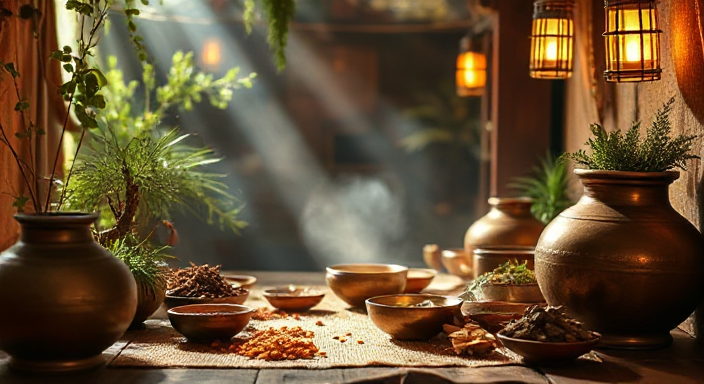
Amritarishta is not simply a herbal concoction; it represents a complex interplay of natural ingredients, carefully selected and combined to enhance therapeutic efficacy. This article aims to provide an in-depth exploration of Amritarishta, covering its composition, traditional applications, dosage guidelines, potential side effects, essential precautions, and relevant modern insights, offering a balanced and comprehensive overview.
Table of Contents
Ingredients: The Composition of Amritarishta
Amritarishta is a meticulously crafted formulation that harnesses the synergistic properties of various herbs and spices. The ingredients are chosen based on their specific actions and combined to address targeted imbalances within the body. Here is a detailed list of the main components, including their common names, botanical names, and their Ayurvedic properties:
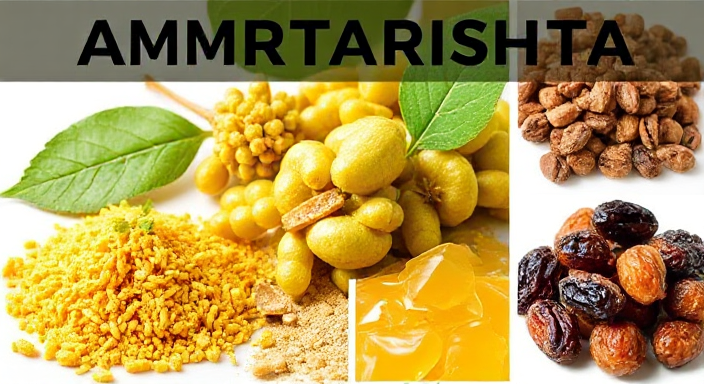
| Ingredient (Common Name) | Botanical Name | Ayurvedic Properties (Rasa, Guna, Virya, Vipaka) | Purported Role in Formulation |
| Guduchi (Giloy) | Tinospora cordifolia | Tikta, Kashaya, Laghu, Ushna, Madhura | Immunomodulator, adaptogen, anti-pyretic, anti-inflammatory |
| Dashmool (Ten Roots) | Various | Varies with each herb | Balances Vata dosha, anti-inflammatory, analgesic, promotes overall vitality |
| (Bilva) | Aegle marmelos | Kashaya, Tikta, Laghu, Ushna, Katu | Anti-inflammatory, digestive, balances Vata and Kapha |
| (Agnimantha) | Premna mucronata | Tikta, Katu, Ruksha, Ushna, Katu | Anti-inflammatory, digestive, reduces swelling |
| (Shyonaka) | Oroxylum indicum | Tikta, Kashaya, Ruksha, Ushna, Katu | Anti-inflammatory, balances Vata and Kapha, analgesic, reduces oedema |
| (Gambhari) | Gmelina arborea | Kashaya, Tikta, Laghu, Sheeta, Madhura | Improves digestion, balances all three doshas |
| (Patala) | Stereospermum suaveolens | Kashaya, Tikta, Laghu, Ushna, Katu | Anti-inflammatory, digestive |
| (Shalaparni) | Desmodium gangeticum | Tikta, Kashaya, Laghu, Ushna, Katu | Balances Vata and Pitta, anti-inflammatory, reduces fever |
| (Prishnaparni) | Uraria picta | Tikta, Kashaya, Laghu, Ushna, Katu | Balances Vata and Pitta, anti-inflammatory |
| (Brihati) | Solanum indicum | Tikta, Katu, Ushna, Laghu, Katu | Anti-inflammatory, reduces fever |
| (Kantakari) | Solanum xanthocarpum | Tikta, Katu, Ushna, Laghu, Katu | Reduces respiratory ailments and inflammation |
| Draksha (Raisins) | Vitis vinifera | Madhura, Guru, Sheeta, Madhura | Base for fermentation, nutritive, improves taste and palatability |
| Dhataki Flower | Woodfordia fruticosa | Kashaya, Ruksha, Sheeta, Katu | Facilitates fermentation, imparts color, contains tannins |
| Jaggery | Saccharum officinarum | Madhura, Guru, Ushna, Madhura | Sweetening agent, promotes fermentation |
Understanding Ayurvedic Properties
The Ayurvedic properties (Rasa, Guna, Virya, and Vipaka) are essential to understand the action of each ingredient and the overall effect of Amritarishta:
- Rasa (Taste): Defines the taste of an ingredient such as Madhura (sweet), Katu (pungent), Tikta (bitter), Kashaya (astringent), Amla (sour), and Lavana (salty).
- Guna (Qualities): Describes attributes such as Guru (heavy), Laghu (light), Sheeta (cold), Ushna (hot), Ruksha (dry), and Snigdha (unctuous).
- Virya (Potency): The heating or cooling action of an ingredient on the body.
- Vipaka (Post-Digestive Effect): The taste that develops after digestion – either Madhura (sweet), Amla (sour), or Katu (pungent).
The unique combination of these properties allows the herbs in Amritarishta to balance doshas, promote immunity, and alleviate ailments. The formulation is primarily designed to enhance Ojas (vitality) and reduce Ama (toxins).
Top 10 Benefits and Uses of Amritarishta
| # | Benefit/Use | Description | Ayurvedic Principle/Basis |
| 1 | Boosts Immunity | Strengthens the body’s defense mechanisms, improves resistance to infections, and enhances overall immunity. | Enhances Ojas (vitality) and Vyadhikshamatva (immunity) due to properties of Guduchi |
| 2 | Reduces Fever (Anti-Pyretic) | Helps to bring down body temperature during fevers, particularly mild to moderate fevers, by addressing underlying imbalances and infections. | Balances Pitta dosha and helps reduce Ama that is a cause of fever |
| 3 | Provides Rejuvenation (Rasayana) | Acts as a tonic that promotes overall vitality, increases energy levels, and aids in post-illness recovery. Supports overall well-being by balancing the body systems. | Rasayana action enhances Dhatus (tissues), and improves overall physical and mental strength |
| 4 | Anti-inflammatory Action | Helps to reduce inflammation throughout the body, particularly in mild inflammatory conditions. Soothes joint and muscle pain. | Balances aggravated Vata and Pitta, also helps clear Ama which often leads to inflammation. |
| 5 | Supports Respiratory Health | Helps relieve symptoms associated with respiratory ailments, such as cough, cold, and other respiratory tract infections. It may help in reducing congestion. | Balances Kapha and Vata dosha associated with respiratory problems |
| 6 | Improves Liver Function (Indirectly) | By promoting detoxification and reducing metabolic waste, it indirectly supports the liver. | Improves Agni and promotes Srotoshodhana (cleansing of channels) |
| 7 | Adaptogenic Properties | Improves the body’s ability to handle stress and environmental changes, promoting overall resilience. | Guduchi, the main ingredient, has significant adaptogenic action. |
| 8 | Helps in Convalescence | Supports the body during recovery from illnesses, helping regain strength and vitality. It promotes tissue repair and boosts immunity. | Acts as Balya (strengthening) medicine by providing nutrition and immunity. |
| 9 | Balances Vata and Pitta Doshas | The unique combination of herbs helps to balance the aggravated Vata and Pitta doshas, contributing to improved overall health and well-being. | Specific herbs in the formulation helps regulate Vata and Pitta doshas |
| 10 | Provides Antioxidant Support | The herbs in Amritarishta have antioxidant properties that combat free radicals and help prevent oxidative stress, thus preventing cell damage. | Many ingredients in the formulation help eliminate free radicals and reduce oxidative stress. |
Important Notes:
- Traditional Perspective: These benefits are rooted in traditional Ayurvedic principles.
- Individual Variation: The effectiveness of Amritarishta can vary from person to person based on their individual Prakriti and overall health status.
- Supportive Remedy: Amritarishta is not a primary treatment for serious or chronic conditions, but a supportive therapy used to improve and balance health.
- Professional Advice: It is important to consult a qualified Ayurvedic practitioner or healthcare professional before using Amritarishta.
- Modern Evidence: While many ingredients have been studied for individual properties, limited research exists on the combined effect of the formulation as a whole.
Source and Quality of Ingredients
The potency of Amritarishta is directly linked to the quality of its raw materials. Traditionally, the herbs are sourced from their natural habitats, harvested during specific seasons to ensure optimal potency. In modern times, many manufacturers use cultivated herbs, which if managed properly, can still be effective.
However, the source of raisins, gud (jaggery), and the dhataki flowers, should also be of good quality and authenticity should be verified. Adulteration is common with herbal formulations; hence sourcing materials from certified vendors and reputed manufacturers is extremely important.
Traditional Uses of Amritarishta
Classical Ayurvedic texts, including the Bhaishajya Ratnavali and Charaka Samhita, document the traditional uses of Amritarishta. It is primarily valued for its ability to:

- Boost Immunity: Guduchi, the primary ingredient, is renowned for its immunomodulatory properties, helping to strengthen the body’s natural defenses and improve resistance to infections.
- Reduce Fever (Anti-Pyretic): The combined actions of Guduchi and other herbs help to reduce fever by balancing Pitta dosha and combating infections. It is employed in mild to moderate fevers.
- Rejuvenate the Body (Rasayana): It is considered a Rasayana medicine that promotes overall vitality, energy levels and well-being. It is useful in convalescence after illnesses and debilitating conditions.
- Alleviate Respiratory Ailments: Some ingredients, particularly Kantakari and Brihati, help to reduce symptoms associated with respiratory tract issues, supporting the overall respiratory health.
- Anti-inflammatory and Analgesic: The presence of the herbs in Dashmool, along with Guduchi, imparts an anti-inflammatory action that is beneficial in various inflammatory conditions and reduces pain.
Amritarishta is often prescribed as a supportive remedy during recovery from illnesses and as a general tonic for improved health.
Primary vs. Secondary Uses
The primary focus of Amritarishta is on enhancing immunity, reducing fever, and providing rejuvenation. Its use as an anti-inflammatory and respiratory aid can be considered secondary, offering additional benefits that support the primary functions.
Modern Perspectives: Limited Scientific Evidence
While Amritarishta is widely used in traditional Ayurvedic practice, there is limited robust modern scientific research on its efficacy as a whole formulation. However, the individual ingredients have been studied to some extent: Guduchi has shown significant immunomodulatory, anti-inflammatory, and anti-pyretic properties in research, along with supporting its adaptogenic effects. Many herbs in Dashmool have anti-inflammatory and analgesic properties. However, research validating the combined effect of Amritarishta is still in its initial stages. Much of the current information stems from traditional knowledge and anecdotal evidence.
Preparation Methods
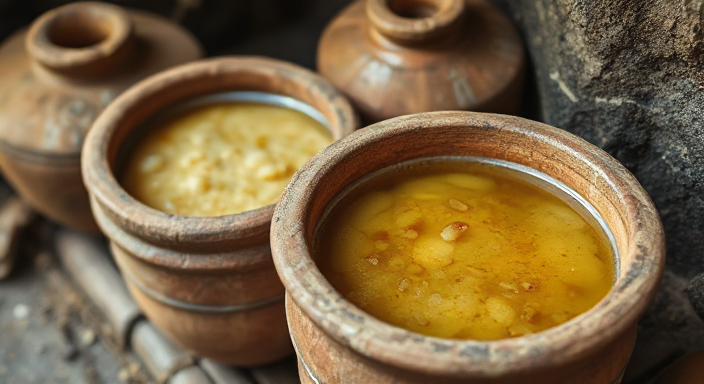
- Infusion: The ingredients, in both powdered and whole forms, are added to water and jaggery.
- Fermentation: The mixture is then placed in an airtight container, where it undergoes a process of natural fermentation. Dhataki flowers are usually added to enhance the fermentation process.
- Maturation: This mixture is left for a specific period (usually several weeks or months), allowing the herbs to release their active constituents, and the mixture is transformed into arista.
- Straining and Bottling: The matured liquid is strained and bottled, ready for use.
- Quality Control: Standard procedures are adhered to during the commercial manufacturing process.
The result of this fermentation is a self-generated alcoholic preparation with a characteristic herbal flavor and therapeutic properties. Due to limited information available regarding proprietary manufacturing process, the above mentioned is generalized information of making aristas.
Dosage Guidelines
Dosage recommendations for Amritarishta are often based on individual age, body constitution (Prakriti), the health condition being addressed, and digestive capacity. General guidelines are:
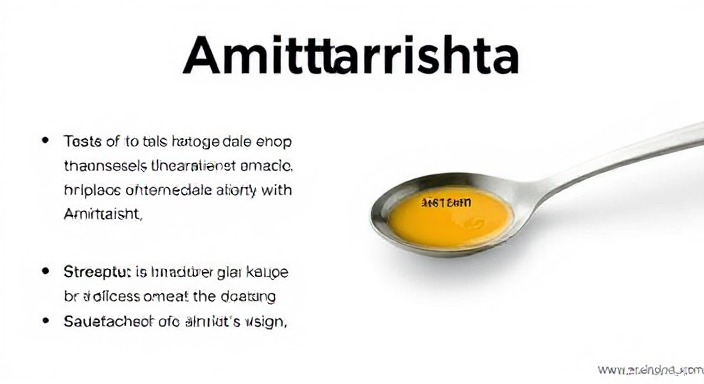
- Adults: 10 to 20 ml (2-4 teaspoons) twice daily after meals, or as directed by an Ayurvedic practitioner.
- Children: Dosage should be considerably reduced, and it’s best administered under the supervision of a qualified practitioner.
- Specific Conditions: The dosage may need adjustments based on the particular ailment being treated. A slightly higher dose might be used for an active fever, whereas a lower dose may be suitable for general well-being.
Importance of Prakriti
Ayurveda emphasizes personalized medicine. Prakriti plays an important role in determining the appropriate dosage. Individuals with a Pitta constitution need to be careful with heating medicines, as Amsritarishta is slightly hot in potency; hence, a lower dose may be ideal. Vata and Kapha types can usually tolerate higher doses if their digestive fire is good.
Dosage Forms
Amritarishta is available as a liquid and should be consumed orally. It can be taken directly or diluted in a small amount of water. It is also available in capsule form, but liquid is the most traditionally used format.
Side Effects and Precautions
Although generally considered safe when used as directed, Amritarishta can have certain side effects and precautions:

- Digestive Upset: Overconsumption may cause digestive disturbances, such as mild stomach upset.
- Alcohol Content: Because it is a fermented preparation, it contains alcohol. This is a very important consideration for individuals who are sensitive to alcohol.
- Allergic Reactions: Allergic reactions to any of the herbs can occur. It is essential to watch out for any unusual symptoms after taking the formulation.
- Drug Interactions: It may interact with certain medications, particularly immune suppressants, or other herbal drugs.
- Pregnancy and Breastfeeding: It is generally contraindicated during pregnancy and breastfeeding due to limited safety data and the alcohol content.
- Contraindications: Those with acute gastritis, and peptic ulcers should be careful in using this preparation.
The Importance of Professional Consultation
Seeking advice from a qualified Ayurvedic practitioner is paramount before using Amritarishta, especially if:
- You have any underlying health conditions.
- You are on prescription medications.
- You are pregnant or breastfeeding.
- You are not aware of your Prakriti or the appropriate dosage.
A practitioner can offer personalized recommendations based on your individual needs.
Quality and Storage
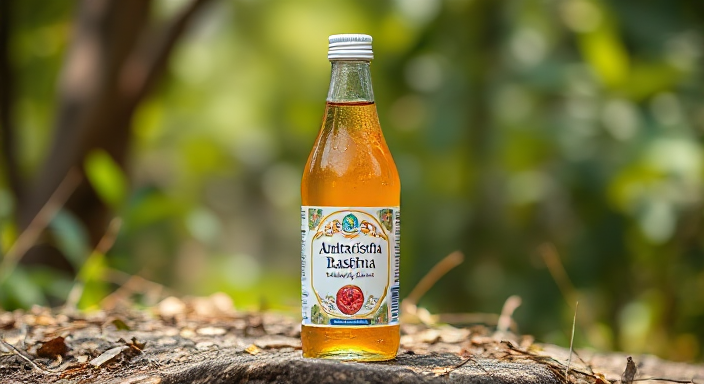
Always select Amritarishta from reputable manufacturers that follow good manufacturing practices and adhere to quality standards. Store the formulation in a cool, dark place, protected from direct sunlight and heat. It should be stored in a tightly sealed glass bottle or container and consumed within the stated expiry period. Any unusual change in colour, odor or taste indicates poor quality.
Disclaimer
The information provided in this article is for educational purposes only and should not be interpreted as medical advice. The use of Amritarishta should be under the guidance of a qualified healthcare professional. Self-treatment without professional supervision can be harmful.
Conclusion
Amritarishta is a potent Ayurvedic medicine renowned for its immunomodulatory, anti-pyretic, and rejuvenating properties. It is important to approach its use with caution, being mindful of potential side effects, contraindications, and the presence of alcohol. By prioritizing professional consultation and using it responsibly, one can benefit from the traditional knowledge and therapeutic properties of Amritarishta.
FAQs About Amritarishta
1. Is Amritarishta safe for boosting immunity?
Amritarishta is traditionally used to support and boost the immune system; however, its safety depends significantly on proper usage and individual health factors. It is crucial to consult an Ayurvedic practitioner or healthcare professional before beginning its use to determine if it is suitable for your specific needs and condition. It’s also generally not recommended for pregnant women or individuals with certain pre-existing medical conditions.
2. How quickly can Amritarishta help reduce a fever?
The time it takes for Amritarishta to help reduce a fever can vary from person to person. It is generally understood to assist in gradually bringing down body temperature by addressing underlying imbalances. When used in conjunction with a balanced diet and adequate rest, it can be beneficial. For high fevers or persistent conditions, seeking medical advice from a qualified healthcare provider is extremely important.
3. Can Amritarishta be used as a daily health tonic?
Amritarishta is indeed considered a Rasayana in Ayurveda, which is a type of medicine used to promote overall health and well-being and it can help improve the general health when used appropriately. However, it should not be used for extended periods without a break and needs to be monitored by a professional. Consulting a professional to determine its suitability as a daily health tonic is always the right approach to ensure correct usage and dosage based on individual requirements.
4. What are the key ingredients that make Amritarishta effective?
The primary ingredient in Amritarishta is Guduchi, also known as Giloy, which is celebrated for its potent immunomodulatory properties. In addition, the formulation contains a synergistic blend of Dashmool (ten roots), raisins, and other beneficial herbs and spices. This combination contributes to the formulation’s effectiveness in boosting immunity, promoting rejuvenation, and reducing inflammation.
5. Is Amritarishta safe for individuals with diabetes?
Amritarishta contains jaggery, a type of sugar, as one of its main ingredients. Therefore, individuals with diabetes need to be particularly careful. Consulting with their doctor or a qualified Ayurvedic practitioner is essential to determine if it is safe to consume and if any modifications to their diet or medications are necessary to avoid spikes in blood sugar levels.
6. How does Amritarishta compare to other Ayurvedic immunity boosters?
Amritarishta is unique as it uses Guduchi as its main ingredient which is known for its immuno-modulatory properties and along with other ingredients it is known to help reduce fever and help in convalescence from illnesses. Other Ayurvedic formulations for immunity boosting may use different ingredients with distinct mechanisms of action. Choosing between them would depend on individual needs; professional advice is key.
7. What’s the best time to take Amritarishta – before or after meals?
It is generally recommended to take Amritarishta after meals. This practice is thought to aid in digestion and improve the overall absorption of the formulation. However, the specific timing may be adjusted by your Ayurvedic practitioner based on your individual health condition and other factors.
8. Can Amritarishta interact with prescription medications?
Yes, there is a possibility of interactions between Amritarishta and certain prescription medications, especially immune suppressants. Individuals who are taking prescription medications must always consult with their doctor or an Ayurvedic practitioner before using Amritarishta to ensure no adverse drug interactions or side effects.
9. How long should I continue taking Amritarishta to see noticeable benefits?
The duration of time needed to experience noticeable benefits from Amritarishta can vary. While some may notice improved energy levels within a few days, others may need several weeks to see a more considerable difference. Long term use is not advisable and should be monitored by health professional. It is crucial to adhere to the prescribed dosage and duration for the desired effect.
10. Is it okay to take Amritarishta daily, or should I take it in intervals?
Although Amritarishta can be taken daily, long-term continuous use is not generally recommended without breaks. It is important to follow the advice of your Ayurvedic practitioner or health professional, who can provide a personalized usage plan tailored to your specific health needs, and to avoid self-treatment.
